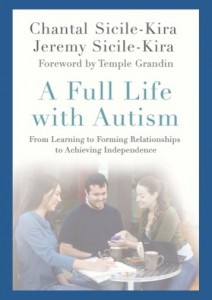The Colors of My Life as a Young Boy
Happy days are represented by yellow and green for the calm of doing nothing. Blue for the knowledge my mom gave me. Truly my mom gave me hope represented by white. Truly my mom was the first one who saved me from despair represented by little strokes of red. Greatly my life was mostly pleasant represented by the color of nice light orange. Gold from above is helping. Greatly my life is better now. – words and painting by Jeremy Sicile-Kira
Thinking about when your child ages out of school services is pretty scary for most parents of teenagers with autism. The reality is that parents can create a successful future for their child. But it doesn’t just happen overnight – it’s about having a plan and using the IEP process.
If there is anything I’ve learned as a parent of a child with autism, it’s that you can’t just leave it up to the system – school or adult services – to figure it out. You have to be involved. It’s important for parents to realize that when your child ages out of school into adult services – your child ages out of mandated services. Under IDEA – the Individual with Disabilities in Education Act – all students are guaranteed a free and appropriate education.
When your teen or young adult either graduates from high school or ages out of school services (at age 22 in most states) – there is nothing guaranteed for your adult child. Your adult child may be eligible for services, but that does not mean that he or she will receive services. It means they will be eligible to get on waiting lists.
This is why it’s important to plan ahead and to use the IEP system to get the goals and objectives on the student’s IEP to learn what they need to learn in order to be successful adults. There are life skills that every person needs to learn to be able to get and keep a job, enjoy their free time, live as an adult as independently as possible. The ITP – Individualized Transition Plan – exists to plan for the student’s hopes and dreams for their future as adults. Once the ITP is written, the IEP should have goals and objectives that reflect the ITP. Just like your child’s earlier school years, don’t accept the status quo in transition programs because ‘that’s what we do here’ if it doesn’t fit your child’s needs.
Every student is different, but goals and objectives can be written for every type of person – every student’s ability. Everyone is able to learn – but educators and parents have to be cognizant of HOW that student learns best and WHAT motivates them. Do they have something they really like to do? What are their strengths? For some it is not as obvious. For example, Jeremy just liked to stim, mostly. He liked looking at colors and patterns on book covers and on rugs. Then he liked learning, and writing when he learned how to communicate by typing – which was a long process. Then he discovered painting – which he did not like as a child, probably because of the sensory aspects. Turns out those patterns he liked, were really full of colors he was dreaming about at night. But we didn’t know that till he was 23 years old!
The point is, never give up on your child – or teenager – or adult. Learning is forever. But it is only while your child is still eligible for mandated school services under IDEA that he or she will be guaranteed the educators and supports needed to learn. But be cognizant that the school system can’t do everything. What can you do that will help your child prepare for the future, or how can you support your child’s educator and classmates? For example, If your child has a certain interest, can find someone to mentor him in that after school? Is your child learning to do some chores? Can you find your teenager a volunteer job so he learns responsibility? Can you partner with other parents and support each other and possibly create some options together?
Obviously, this is easier in some cases that for others. We’ve had to spend a lot of time and energy over the years to create opportunities for Jeremy because of his sensory-motor challenges. Jobs or functional living skills that require a lot of fine motor skills are really challenging for him. Meanwhile he has a productive life doing what he loves, while still working on those living skills he needs to learn. He has a great support team, and has his independence, but we are still involved in helping him create his adult life based on his wants and needs. And there is no way we could do it alone, or that any agency could do it alone. It does take a village!
My son Jeremy and I co-authored A Full Life with Autism so that parents and educators could learn more about the reality of adult services is, and to offer suggestions on how to best prepare a student with autism for real life. Model programs that parents and professionals have successfully created together are provided. We hope the book informs you, and inspires you to plan ahead using the IEP process and whatever else you can do. We also hope it will inspire parents to get involved and help create the future with other
like-minded parents and professionals. Together, we can make a difference and create the future.
Chantal Sicile-Kira is an author, speaker and consultant on autism, adolescence, transition services and the effects of autism on the family. Chantal can be reached here. Feel free to leave comments below.






